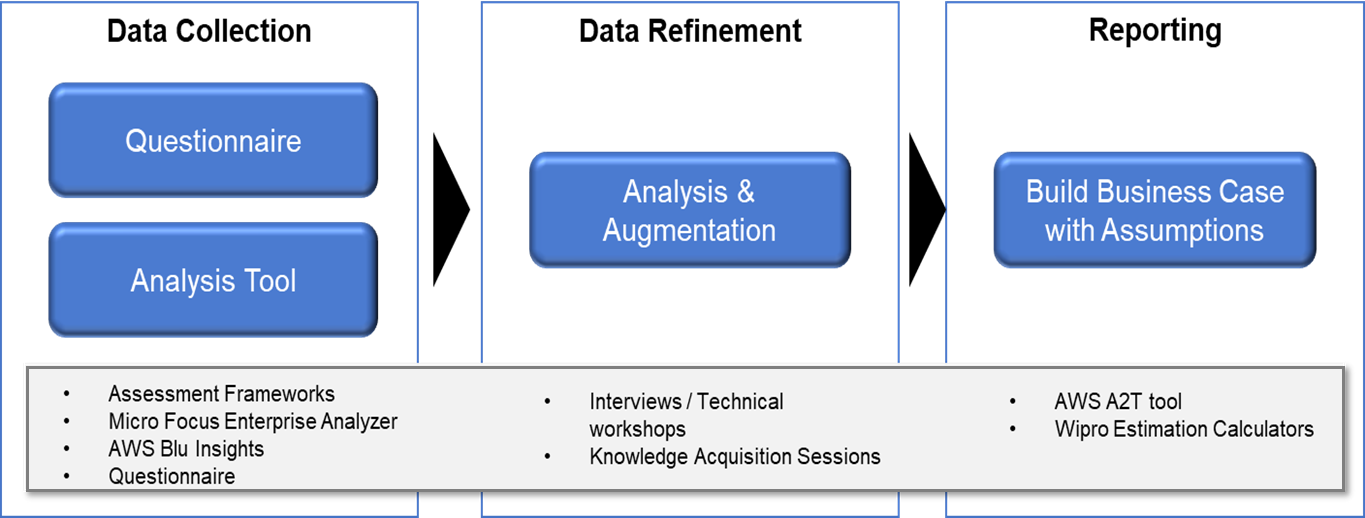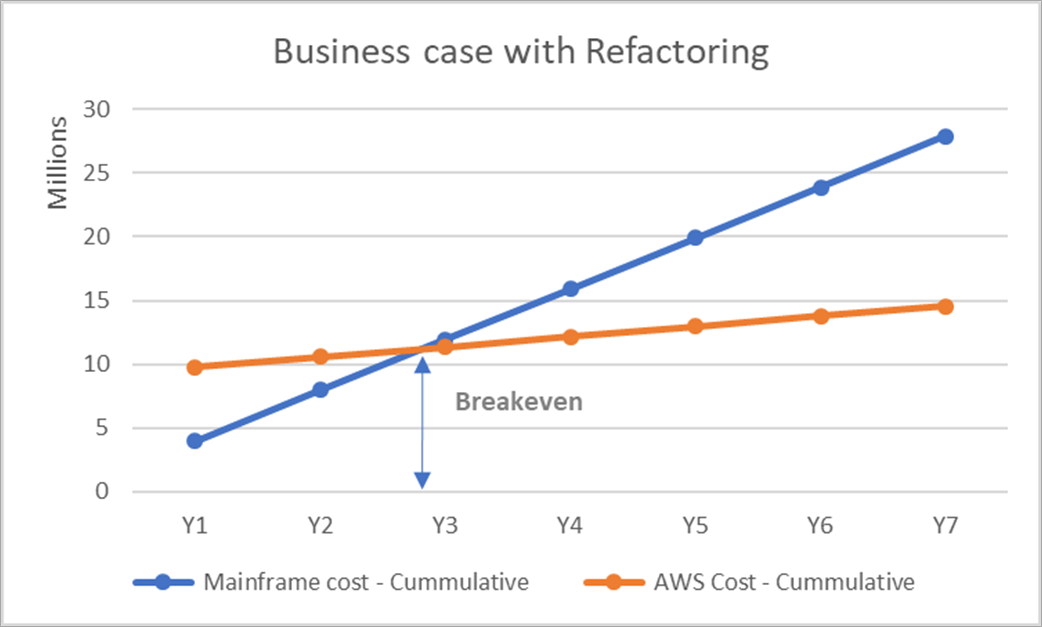AWS Partner Network (APN) Blog
Unlocking the Future: Wipro’s Business Case-Driven Approach for Mainframe Modernization on AWS
By Sujith Kochaniyan, Practice Leader – Wipro
By Gagan Sethi, Sr. Partner Solutions Architect, Strategic Deals – AWS
By Vipin Gupta, Sr. Partner Solutions Architect, Mainframe Modernization – AWS
 |
| Wipro |
 |
Mainframes have been in existence for more than five decades supporting business-critical applications across industries. These applications have intricate integrations and have accumulated technical debt over time.
Changing business requirements have compelled IT organizations to become more agile and scalable to deliver products and services faster. In addition, factors such as a shortage of skills, vendor lock-in, high total cost of ownership (TCO), poor user experience, and data silos have become key drivers for modernizing mainframe applications.
To embark on a successful journey of mainframe modernization, it’s crucial to have a plan that aligns with business priorities and technical drivers.
AWS Mainframe Modernization Service provides multiple approaches to meet customers’ objectives. Some of these approaches are automated from assessment to migration, but there is not a one-size-fits-all mainframe modernization approach.
Depending on business strategy and mainframe-specific technical constraints, customers can select the most suitable approach for their needs. A common approach for tool-based mainframe modernization includes automated refactoring and re-platforming.
- Automated refactoring employs industry tools to automatically convert code, data, and dependencies into modern language, data stores, and frameworks, while also ensuring functional equivalence with the same business functions.
- Replatforming replaces mainframe middleware APIs and operating system (OS) APIs required by the application. A majority of the application source code is recompiled on Amazon Web Services (AWS) without changes and with some adaptations for changed dependencies.
Through fast-paced and tool-based modernization approaches, companies can gradually move applications and permanently shut down a mainframe workload within one to two years.
This post aims to provide an overview of the relevance, challenges, approach, and methodology employed by Wipro and AWS in creating a business case for mainframe modernization through a financial lens that takes technical considerations into account and aligns with business outcomes.
Wipro is an AWS Premier Tier Services Partner with many AWS Competencies, including Mainframe Modernization Consulting. Wipro is also a member of the AWS Managed Services Provider (MSP) and Well-Architected Partner Programs.
Purpose of the Business Case
Mainframe modernization typically involves stakeholders from various business and technology domains who assess business value, TCO, and return on investment (ROI), as well as technology risks and complexity to determine the best approach.
The financial viability of a mainframe modernization business case is typically categorized into three main areas: Current Cost of Ownership (TCO-Current), Target Cost of Ownership (TCO-Target), and One-Time Cost to exit the mainframe (OTC-Modernize).
One-Time Cost for modernization will depend on the chosen approach (replatform, refactor, repurchase). Additionally, the current spend on mainframes may be determined by licensing agreements with the current hosting provider, while future cloud spend may be affected by consumption models and pricing agreements. Consequently, a business case must be built on its own financial assumptions.
In addition, ROI visibility is crucial and provides insight into the costs associated with migrating to the cloud, recovery time for the investment, and year-over-year savings. When many legacy applications run on mainframes, prioritizing and grouping them is essential for realizing the benefits of mainframe modernization quickly.
Although there are multiple drivers and approaches of transitioning away from mainframe applications, developing a technology roadmap, defining operational requirements, and building sound exit strategies is key for a strong business case.
Creating a Mainframe Modernization Business Case
Wipro and AWS employ the following methodology and framework for creating a business case, which can be developed either as part of the application assessment process or during the initial phases of strategizing, using the available information.
Figure 1 – Methodology for business case creation.
The process of data collection involves gathering application information and inventory, which can be accomplished through non-intrusive methods like questionnaires, existing system documentation, and technical workshops to establish possible modernization patterns and tools. A tool-based discovery can facilitate faster inventory gathering while providing more in-depth and accurate knowledge of the system.
The data refinement process entails analyzing the system information that has been gathered and supplementing it with additional information acquired through knowledge acquisition sessions or interviews/technical workshops with key application stakeholders. Wipro brings its industry-focused domain and consulting practice expertise and methodologies for comprehensive view of the customer environment.
During the reporting process, the collected information is input into the AWS Assessment Tool (A2T) to import and validate customer data. Wipro’s estimation calculators help in determining cloud consumption and one-time bubble cost. These tools enable the creation of a financial business case with necessary assumptions.
Accelerators to Support Analysis and Business Case Creation
An understanding of the customer’s modernization goals, cloud readiness, current mainframe landscape, and IT environment can help assess the complexity of a potential modernization with recommended actions to develop a business case.
AWS Assessment Tool helps in asking important questions, so you can have the answers in a centralized repository for reference in the different stages of the opportunity. This helps in knowledge sharing for better communication and transitioning between teams working through different phases of modernization.
Mainframe portfolio analysis and insights to application inventory for application dependencies, interfaces, data flows, interactions with upstream and downstream systems, and other application characteristics are key inputs to define a modernization strategy and determine the one-time migration cost. AWS Mainframe Modernization Service provides automated tools to reduce the time and cost of assessment and eliminates the need to procure product licensing during the assessment.
Figure 2 – Analysis and business case creation accelerators.
Wipro has developed estimation calculators to determine the initial modernization cost for replatforming, automated refactoring, and rewrite/re-architecting. These tools have been used to estimate project size and facilitate the entire process, from strategy assessment to execution and deployment.
Wipro continuously reviews and refines the estimation models based on lessons learned and advancements in automation capabilities. These tools are highly adaptable and can accommodate changes in scope, productivity, and technology landscape due to their parameterization and flexibility. The models incorporate various productivity boosters offered by Wipro’s ModerniZ platform to expedite the modernization journey.
Wipro’s ModerniZ is an integrated end-to-end modernization platform to transform monolithic legacy mainframe applications to cloud-native applications. It’s built with multiple in-house and partner-sourced tools to accelerate modernization programs:
- PAN Legacy Analyzer (PAN) helps in capturing inventory details of mainframe applications and improves the productivity in maintenance of inventory. It scans all mainframe components (COBOL, JCL, PROC, Control Cards, MAPS) and creates inventory reports with relationship mapping between the components. It has a Java-based user interface (UI) to enable better visualization of data created by REXX scripts. It can deliver up to 60% effort saving in inventory collection.
- UI Builder is a low-code, no-code platform that helps to create Angular/React single-page applications using pre-built widgets with drag-and-drop features to transform legacy green screens to modern technology. This automation of bootstrapped code can save up to 40% of development time.
- ModerniZ DB helps in the automated transformation of legacy relational database management system (RDBMS) objects to a modern cloud-based target database with relative ease. It simplifies the application by separating database layer and can deliver up to 60% productivity gain.
- Compare Tool helps in the comparison of data files from legacy applications and target/transformed applications to support data validation in legacy migration projects. It has a command line interface (CLI) version as well to enable comparison of large sets of files in batch mode; the results can be downloaded in JSON or HTML format.
Figure 3 – Wipro ModerniZ platform.
Sample Business Case for Mainframe Modernization
The initial step involves determining the required target environment size on AWS for either the workload or entire mainframe site. Starting with specific workloads is a beneficial approach for medium to large mainframe installations, as customers typically utilize workloads as a boundary for initiating phased modernization.
To create a business case, this post utilized a sample small mainframe installation. The customer has a business-critical system running on mainframe with two LPARS (Prod, Dev) consuming 1,000 MIPS with the following technology stack:
- Cobol programs: ~ 2,500 (70% batch)
- Lines of code: ~ 2.8 M
- JCLs: ~ 800
- DB2: 500+ tables
- Files: 750+
- Data volume: 196 GB
- Interfaces: ~20 (upstream + downstream)
The customer needs to exit the on-premises mainframe system within a year and modernize the application to Java. Based on their business and timeline drivers, automated refactoring approach using AWS Blu Age was considered for modernization.
The following tables and chart depict a mainframe modernization business case leveraging AWS Mainframe Modernization Service for automated refactoring.
Customer Spend (YoY)
Figure 4 – Customer mainframe spend.
AWS infrastructure cost includes managed runtime for running workloads, compute resources for scheduler, operational data storage, archive data storage, and disaster recovery resources. The calibration of modernization testing and code refactoring is based on the estimation model created by Wipro, which is based on past modernization experiences.
When organizations are incurring new expenses for a cloud migration while still covering the costs of their current on-premises infrastructure, a “bubble” is created. This bubble, or one-time modernization cost, encompasses expenses related to the AWS project infrastructure, consulting services, code refactoring, and modernization testing, and cost of any other software integration.
Customers must make an initial investment to finance the bubble cost. Depending on the size of the mainframe workload and chosen approach, mainframe modernization can be a multi-year journey. It’s crucial to have a comprehensive understanding and comparison of the cash flow statement during a specific period, which shows the total cost with no modernization, cost involved in embarking on the mainframe modernization journey, and effective savings with the bubble cost.
As depicted in the graph below, post modernization in year two, the up-front investments is recovered from the YoY savings realized by migrating to AWS.
Figure 5 – Business case with automated refactoring.
Business Case Considerations
- Mainframe cost based upon industry standard metrics.
- AWS cost includes AWS services and other third-party software, such as a scheduler for all environments with high availability and disaster recovery architecture as per customer requirements.
- One-time modernization cost is estimated using methodology and tools described above.
AWS Value Accelerators for Business Case Assessment
- AWS Assessment Tool: A2T is an online platform developed by AWS for delivering a multitude of surveys, questionnaires, and assessments for both internal and customer-facing engagements. It provides a safe and secure means to gather information, complete an analysis, and generate a report where applicable.
- AWS Migration Acceleration Program for Mainframe: The AWS Migration Acceleration Program (MAP) for Mainframe, an extension of the existing AWS MAP program, is designed to help organizations reach their migration goals even faster with AWS services, best practices, tools, and incentives.
- AWS Blu Insights: An assessment tool for automated source code assessment and includes calculator for the modernization project cost.
Conclusion
Enterprise executive approval for mainframe modernization requires an understanding of the expected financial commitment and potential business benefit. These benefits can include productivity enhancement, better data and analytics capabilities, improved customer satisfaction, and faster feature release through modern development practices.
The methodology and toolsets used by Wipro and AWS provide current environment insights, current and target total cost of ownership, and one-time migration cost for a business case. This accelerates the assessment process and helps customers make informed decision aligning their business strategies and priorities.
For related questions, contact Wipro at aws-migratemodernize@wipro.com.
Wipro – AWS Partner Spotlight
Wipro is an AWS Premier Tier Services Partner and MSP that harnesses the power of cognitive computing, hyper-automation, robotics, cloud, analytics, and emerging technologies to help clients adapt to the digital world.
Contact Wipro | Partner Overview | AWS Marketplace | Case Studies





